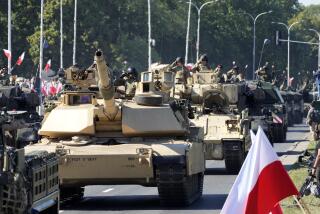Soviet Arms Growth Slows : Annual Outlays Rise 2%, U.S. Agencies Say
- Share via
WASHINGTON — The government’s two chief intelligence agencies have told Congress in a report released Sunday that Soviet defense spending between 1974 and 1985 grew only half as fast--2% a year instead of 4%--as in the preceding decade.
And weapons procurement, they said, rose only 1% annually--roughly the Soviet inflation rate--during most of the same period.
The conclusions were contained in an annual joint report by the Central Intelligence Agency and the Defense Intelligence Agency submitted to the congressional Joint Economic Committee on March 19, with a declassified version released Sunday.
The CIA is responsible for all forms of intelligence and counterintelligence under the President and the National Security Council. The DIA, a unit of the Pentagon, deals with military intelligence and counterintelligence, reporting to the Joint Chiefs of Staff.
Despite the modest Soviet defense spending increases, the two agencies insisted in their report that the Soviet Union made significant gains during the decade both in its strategic forces, such as nuclear missiles, and in its conventional capabilities, including tanks and guns.
“If true, it was a neat trick,” Sen. William Proxmire (D-Wis.) said in a statement accompanying release of the CIA-DIA report. “The Soviets’ most closely guarded secret may now be how to strengthen defense in the midst of a virtual procurement freeze.”
Proxmire’s barb was aimed at the Pentagon, which has requested huge budget increases to increase U.S. military capability. In contrast to the 1% annual growth rate of Soviet defense procurement, U.S. military procurement has risen by 13% a year from 1981 to 1985, according to a staff member of the subcommittee on security economics, which Proxmire chairs.
A CIA spokesman had no comment on Proxmire’s skepticism. A DIA spokesman suggested that the small annual rise was sufficient to explain the growth in Soviet military capabilities.
Nonetheless, the Soviet defense figures should provide new ammunition for congressional critics of the Pentagon’s request that its 1987 budget grow by 8% on top of expected inflation. The budget request has come under attack by members of Congress who want to cut the huge federal deficit and who are dismayed at waste and fraud by defense contractors.
The CIA and DIA estimated that Soviet weapons procurement costs grew by about 1% annually from 1975 through 1981. But the two agencies remained far apart in their estimates of procurement costs during the next three years. The CIA estimated that the 1% growth rate, roughly equal to inflation, continued through 1984, while the DIA--whose Pentagon superiors buy the weapons for the United States--estimated that the procurement growth rate was 3% to 4% a year.
The report noted that the CIA estimates are more comprehensive. While the DIA looks only at the costs of 350 major weapons systems, the CIA estimates total procurement costs, including organizational equipment and even some weapons not covered by the DIA.
Slowdown Began in 1974
The report said the agencies agreed that Soviet military spending grew by nearly half between 1965 and 1975 and that a slowdown began in 1974 rather than 1976, as previously believed.
Although the report gave no reason for the slowdown, deputy CIA director Robert M. Gates suggested last year that the “stagnation in the level of procurement” came because Soviet leaders in the mid-1970s “may have viewed the external threat as manageable and the existing high level of procurement as enough.”
The two agencies also agreed that the share of Soviet gross national product devoted to the military increased from about 12% to 14% in the early 1970s to the 15% to 17% area in the early 1980s because military spending grew faster than the overall economy. By contrast, the Pentagon budget this year amounts to 6.7% of the U.S. GNP (gross national product).
More broadly, the CIA-DIA report predicted that the ambitious economic program of Soviet leader Mikhail S. Gorbachev, whom it called “the most assertive leader since (Nikita S.) Khrushchev,” will not clash with the military’s weapon procurement for another two or three years.
“Most Soviet weapons expected to be delivered to the Soviet forces through 1990 will be manufactured in plants already built and operating,” it said. Gorbachev’s industrial modernization goals “are unlikely to significantly impede the completion of the major deployments of strategic weapons . . . programmed through the 1980s.”
Real Test in 2 to 3 Years
The real test, it said, “will come in two or three years when renewed demands for expanding and renovating defense industries begin, as defense industries have to start preparing to produce new generations of weapons.”
Machinery needed for domestic and defense industries come from the same economic sector that makes military hardware and consumer durable products, it explained.
Resource allocation choices will then become difficult unless the Soviets have remarkable success during the next few years in raising productivity, increasing the supply of advanced machinery and building more modern industrial facilities, it said.
Based on recent performance, the Soviet economy does not hold promise of such achievements, it indicated. The economy over the past decade, despite continued growth, has failed by ever greater margins to perform up to plans, the report said.
“Soviet GNP growth during the 11th five year plan (1981-85) appeared headed for its worst showing in any five-year plan since World War II,” it said.
More to Read
Sign up for Essential California
The most important California stories and recommendations in your inbox every morning.
You may occasionally receive promotional content from the Los Angeles Times.








